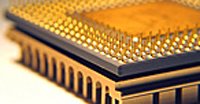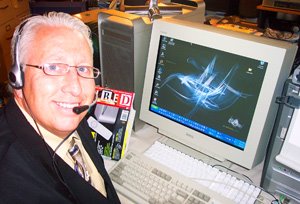New Wireless Concept: Direct2Data
PARKERVISION, INC., OF FLORIDA, this month announced a new line of efficient, high-performance, low-cost wireless chips.

I thought I understood the process of getting information into and out of a radio signal since I got my first ham radio license 35 years ago. No longer. ParkerVision's concept is quite different from the prevailing approach that treats the radio "carrier" and the information components as separate things, like a container and its contents. Their core concept is what the company calls Direct2Data, describing its method as the extracting of data content from a modulated radio signal directly by sampling the energy of that signal.Further discussion of actual benefit requires the use of decibels, a logarithmic measure of power ratios. What happens if you improve the performance of a radio circuit by 21 dB? Radio signal strength falls off with the square of distance, meaning that a doubling of distance results in a fourfold loss of power at the receiver for a given transmitter and antenna configuration. That fourfold weakening is a strength reduction of about 6 dB. A 21 dB improvement would allow almost 3.5 doublings of distance, yielding a factor of an 11.2 increase in range.
Sure enough, the reputable Tom's Hardware site reports that with a ParkerVision access point and wireless card, "We were able to surf the Internet from the far corner of the parking lot, where before we could barely make it past the front door."
ParkerVision's latest initiative is its effort to transfer its energy-efficient innovations from the information-handling sections of radio gear into the power amplifiers as well.
What would it mean to improve the efficiency of a Wi-Fi transmitter's output stage from, say, 4 or 5 percent to the 40-plus percent that ParkerVision claims to be able to achieve? It means putting out a watt of radio energy with only a 2.5-watt load on the battery, compared with the 20 watts that you'd need to get the same output with the less efficient circuit.
Initially, the company claims a 50 to 80 percent power requirement reduction, or a twofold-to-fivefold improvement in the time that a device can be powered with a given amount of battery capacity. I'll take that, thanks.
Note from DC: Remember, it was also Niels Bohr who is said to have told a colleague, "We are all agreed that your theory is crazy. The question that divides us is whether it is crazy enough to have a chance of being correct." ParkerVision's technology appears to be "crazy enough."




















1 Comments:
Please take a look at http://www.pvnotes.com/ for some reasons to be skeptical of ParkerVision's claims.
Post a Comment
<< Home